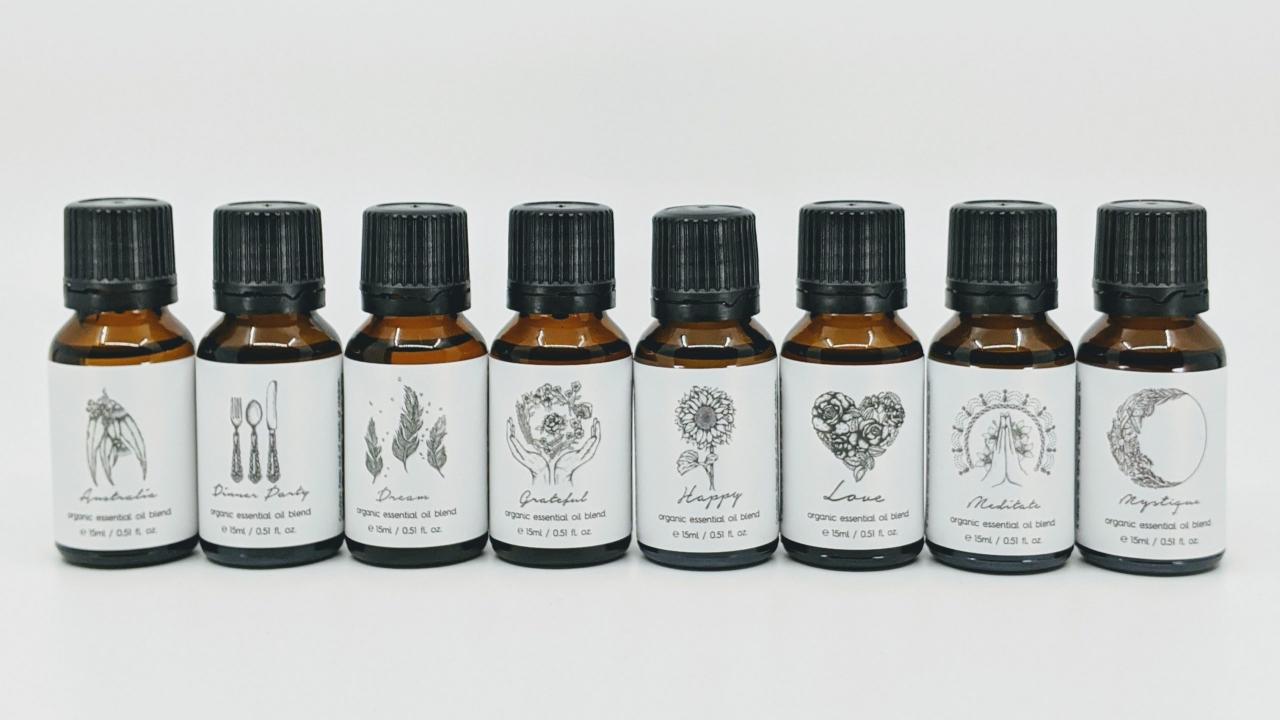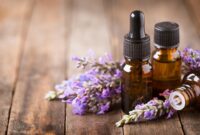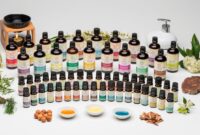Delving into the realm of essential oils for candles, this comprehensive guide unveils the secrets of crafting captivating aromas and ambiance. From exploring the therapeutic properties of these natural essences to mastering techniques for incorporating them into candles, this narrative empowers you to create a sensory experience that transcends the ordinary.
Whether you seek to evoke tranquility, ignite romance, or simply enhance the atmosphere of your surroundings, essential oils offer a myriad of possibilities. Discover the art of blending scents, balancing fragrances, and ensuring safety in candle making. Let your candles become a canvas for creativity, where you can paint with aromas and ignite the senses.
Essential Oil Types for Candles
Essential oils are natural, concentrated oils extracted from plants. They are highly fragrant and possess various therapeutic properties, making them ideal for use in candles. When selecting essential oils for candle making, it’s crucial to choose natural oils over synthetic fragrances, as they provide superior scent quality and potential therapeutic benefits.
Types of Essential Oils for Candles
- Floral Oils:Rose, lavender, and jasmine offer calming and relaxing aromas.
- Citrus Oils:Orange, lemon, and grapefruit provide invigorating and uplifting scents.
- Woody Oils:Cedarwood, sandalwood, and frankincense have grounding and earthy aromas.
- Herbal Oils:Rosemary, peppermint, and eucalyptus offer stimulating and clarifying scents.
- Spicy Oils:Cinnamon, clove, and ginger provide warm and stimulating aromas.
Benefits of Using Natural Essential Oils
- Superior Scent Quality:Natural essential oils have a more complex and authentic aroma than synthetic fragrances.
- Therapeutic Properties:Essential oils can provide potential therapeutic benefits, such as relaxation, stress relief, and improved sleep.
- Environmental Friendliness:Natural essential oils are biodegradable and non-toxic, making them environmentally friendly.
Essential Oil Blends for Candles
Crafting custom essential oil blends for candles offers endless possibilities to create unique and captivating scents. By combining different essential oils, you can tailor the aroma profile to suit your preferences and intended uses.
Popular Essential Oil Blends for Candles
- Relaxing Blend:Lavender, chamomile, and bergamot create a calming and soothing atmosphere.
- Energizing Blend:Peppermint, rosemary, and eucalyptus invigorate and uplift the senses.
- Stress-Relief Blend:Frankincense, clary sage, and ylang-ylang promote relaxation and reduce stress.
- Purifying Blend:Lemon, tea tree, and eucalyptus cleanse the air and promote a healthy environment.
- Sleep-Inducing Blend:Valerian root, lavender, and chamomile promote relaxation and prepare the body for sleep.
Creating Custom Essential Oil Blends
To create custom essential oil blends, consider the following guidelines:
- Determine the desired aroma profile:Identify the scents you want to create, whether calming, energizing, or purifying.
- Research essential oils:Explore the aroma profiles and therapeutic benefits of different essential oils to find those that align with your desired outcome.
- Balance the blend:Combine essential oils in varying proportions to achieve a harmonious and well-rounded scent. Avoid overpowering the blend with any one oil.
- Test and adjust:Experiment with different combinations and ratios until you achieve the perfect blend for your needs.
Importance of Balancing Essential Oils, Essential oils for candles
Balancing essential oils is crucial for optimal fragrance and therapeutic benefits. An unbalanced blend can result in an overpowering or unpleasant scent, or diminished therapeutic effects.
“Balancing essential oils ensures a harmonious and effective blend, allowing each oil to contribute its unique properties without overpowering the others.”
By carefully considering the aroma profiles and therapeutic benefits of each essential oil, you can create custom blends that cater to your specific needs and enhance the ambiance of your space.
Safety Considerations for Using Essential Oils in Candles
The use of essential oils in candles can bring about potential hazards that require careful attention. Understanding these risks and implementing proper safety measures are crucial to ensure a safe and enjoyable candle-making experience.
Fire Risks
- Essential oils are highly flammable and can easily ignite if exposed to an open flame. Always handle essential oils with care and keep them away from sources of heat.
- When adding essential oils to melted wax, use caution and avoid pouring them directly onto the flame. Stir the oils into the wax slowly and gently.
- Store essential oils in a cool, dark place away from heat and direct sunlight. Never leave essential oils unattended near an open flame.
Skin Irritation
Some essential oils can cause skin irritation or allergic reactions in certain individuals. Always perform a patch test before using essential oils on your skin.
- To conduct a patch test, apply a small amount of diluted essential oil to a small area of skin on the inner forearm. Cover the area with a bandage and wait 24 hours.
- If any redness, itching, or irritation occurs, discontinue use of the essential oil and seek medical attention if necessary.
Proper Candle-Making Techniques
Following proper candle-making techniques is essential for safety. This includes:
- Using high-quality wax and wicks that are appropriate for the size and type of candle you are making.
- Measuring ingredients accurately and following the instructions provided in the candle-making recipe.
- Allowing candles to cool completely before lighting them.
Techniques for Incorporating Essential Oils into Candles: Essential Oils For Candles

Incorporating essential oils into candles is a great way to enjoy their therapeutic benefits and create a relaxing or invigorating ambiance. There are several techniques for doing this, each with its own advantages and disadvantages. The most common methods include blending with wax, adding to melted wax, and using essential oil diffusers.
Blending with Wax
Blending essential oils with wax is the most direct method of incorporating them into candles. This can be done by adding the essential oils to the melted wax and stirring until well combined. The recommended concentration of essential oils in wax is typically between 5% and 10%. Higher concentrations can result in a strong scent that may be overpowering or even irritating.
The advantage of blending essential oils with wax is that it allows for a more precise control over the scent of the candle. However, it can be difficult to achieve a uniform distribution of the essential oils throughout the wax, which can result in a candle that has a stronger scent in some areas than others.
Adding to Melted Wax
Adding essential oils to melted wax is a simpler method than blending with wax. Simply add the essential oils to the melted wax and stir until combined. The recommended concentration of essential oils in melted wax is typically between 2% and 5%. Higher concentrations can result in a strong scent that may be overpowering or even irritating.
The advantage of adding essential oils to melted wax is that it is a quick and easy method. However, it can be difficult to achieve a uniform distribution of the essential oils throughout the wax, which can result in a candle that has a stronger scent in some areas than others.
Using Essential Oil Diffusers
Using essential oil diffusers is a great way to add essential oils to candles without having to blend them with wax. Simply add a few drops of essential oil to the diffuser and place it near the candle. The diffuser will disperse the essential oils into the air, which will then be absorbed by the candle.
The advantage of using essential oil diffusers is that it is a simple and convenient way to add essential oils to candles. However, it can be difficult to control the concentration of essential oils in the candle, which can result in a candle that has a stronger scent in some areas than others.
Essential Oils for Different Candle Types
Choosing the right essential oils for your candles is crucial to creating a harmonious and pleasant experience. Different types of candles, such as pillar candles, votive candles, and container candles, have unique characteristics that necessitate specific considerations when selecting essential oils.
Pillar Candles
Pillar candles are known for their large size and long burn time. When choosing essential oils for pillar candles, consider the following factors:
- Scent throw:Pillar candles have a large surface area, so it’s important to select essential oils with a strong scent throw to ensure the fragrance fills the room.
- Burn time:Pillar candles burn for extended periods, so choose essential oils that can withstand the heat and maintain their fragrance throughout the burn.
Suitable essential oil blends for pillar candles include:
- Citrus and spice: Orange, cinnamon, and clove
- Floral and woodsy: Lavender, cedarwood, and sandalwood
- Fresh and herbaceous: Eucalyptus, rosemary, and peppermint
Votive Candles
Votive candles are small and designed to burn for a short period. When selecting essential oils for votive candles, consider the following:
- Subtle fragrance:Votive candles have a limited scent throw, so choose essential oils with a delicate fragrance that won’t be overpowering.
- Quick release:Votive candles burn quickly, so essential oils should release their fragrance rapidly.
Suitable essential oil blends for votive candles include:
- Floral and citrus: Rose, lemon, and bergamot
- Fresh and herbaceous: Basil, lemongrass, and mint
- Earthy and woodsy: Patchouli, vetiver, and frankincense
Container Candles
Container candles come in various sizes and shapes and are typically made of glass or metal. When choosing essential oils for container candles, consider the following:
- Container material:The type of container can affect the scent throw and longevity of the essential oils. Glass containers tend to trap fragrance better than metal containers.
- Candle size:The size of the candle will determine the amount of essential oils needed to achieve the desired fragrance.
Suitable essential oil blends for container candles include:
- Fruity and floral: Strawberry, jasmine, and vanilla
- Spicy and warm: Cinnamon, nutmeg, and ginger
- Exotic and woody: Sandalwood, amber, and myrrh
Essential Oils for Special Occasions and Ambiance
Essential oils can transform the atmosphere of any space, creating specific ambiances and evoking emotions through candles. Whether you seek relaxation, romance, or a festive touch, essential oils offer a versatile and aromatic way to enhance special occasions.
By carefully selecting and blending essential oils, you can create candles that cater to different moods and occasions. Here are some ideas to inspire your own creations:
Relaxation
For a calming and relaxing ambiance, consider using essential oils known for their soothing properties, such as lavender, chamomile, and bergamot. These oils promote tranquility and help reduce stress and anxiety.
Romance
To create a romantic atmosphere, opt for essential oils that evoke passion and intimacy, such as rose, ylang-ylang, and patchouli. These oils are known to stimulate sensuality and create a warm and inviting ambiance.
Festive Occasions
For festive occasions, such as holidays or celebrations, consider using essential oils that bring a sense of joy and cheer. Citrus oils, such as orange, lemon, and grapefruit, are invigorating and uplifting, while cinnamon and nutmeg add a warm and spicy touch.
By experimenting with different essential oil blends and incorporating them into candles, you can create a unique and inviting ambiance for any special occasion or desired atmosphere.
Essential Oils for Therapeutic Candles
Aromatherapy is a holistic practice that uses essential oils for therapeutic benefits. By incorporating essential oils into candles, you can create a relaxing and rejuvenating ambiance in your home.
Certain essential oils possess specific therapeutic properties, such as:
- Stress relief:Lavender, chamomile, and bergamot
- Sleep promotion:Lavender, valerian root, and ylang-ylang
- Mood enhancement:Orange, grapefruit, and lemon
Selecting and Blending Essential Oils
When selecting essential oils for therapeutic candles, consider the desired effects you wish to achieve. For instance, if you want to create a calming atmosphere, opt for relaxing oils like lavender or chamomile.
Blending essential oils allows you to create customized scents and enhance their therapeutic properties. For example, combining lavender and chamomile can promote relaxation and sleep, while blending orange and grapefruit can uplift your mood.
Creative Ideas for Using Essential Oils in Candles

Essential oils offer a plethora of possibilities for creating unique and aromatic candles. Here are some innovative ideas to inspire your candle-making endeavors:
Layered Candles
Create visually stunning candles by layering different essential oil scents. Begin by pouring a base layer of melted wax into the candle container. Once set, add a few drops of your desired essential oil to the next layer of melted wax and pour it on top.
Repeat this process, alternating scents and colors, to create a multi-layered masterpiece.
Scented Candle Wraps
Enhance the ambiance of your candles with scented candle wraps. Cut strips of porous paper or fabric, such as parchment paper or cheesecloth. Apply a few drops of essential oil to the paper and wrap it around the candle. As the candle burns, the essential oil will gradually release its fragrance into the air.
Candle Toppers
Create decorative and fragrant candle toppers using essential oils. Dip pine cones, cinnamon sticks, or other natural elements into melted wax. While the wax is still warm, sprinkle essential oils onto the surface. Once cooled, place the toppers on top of your candles for a touch of rustic charm and a delightful aroma.
Epilogue

As you embark on this aromatic journey, remember that essential oils for candles are not merely fragrances; they are potent tools for creating ambiance, promoting well-being, and igniting inspiration. Experiment with different blends, explore the therapeutic benefits, and unleash your creativity.
Let the enchanting scents of essential oils transform your candles into beacons of tranquility, romance, and pure indulgence.
FAQ Explained
What are the benefits of using essential oils in candles?
Essential oils offer a natural and therapeutic alternative to synthetic fragrances, enhancing the ambiance of your home while promoting relaxation, sleep, and emotional well-being.
How do I choose the right essential oils for my candles?
Consider the desired aroma and therapeutic properties you wish to achieve. Research different essential oils and their benefits to create custom blends that suit your specific needs.
Is it safe to use essential oils directly in candles?
Always dilute essential oils in a carrier oil or wax before adding them to candles. Never burn essential oils directly, as this can pose a fire hazard.


